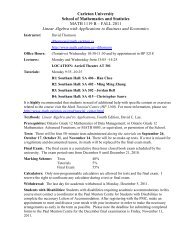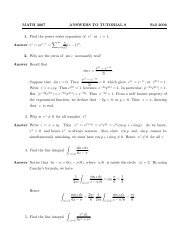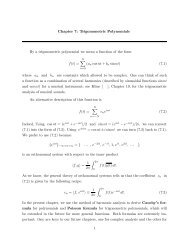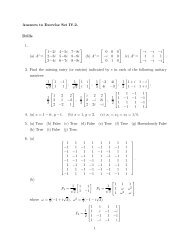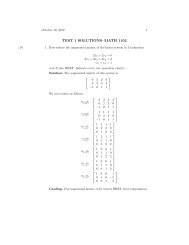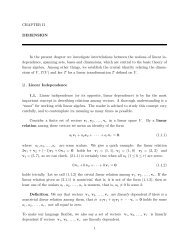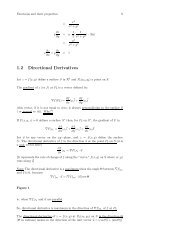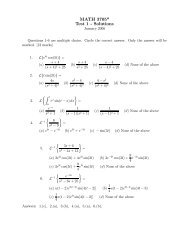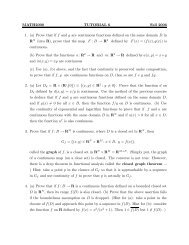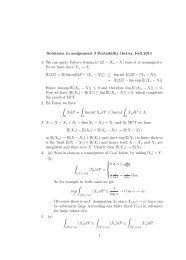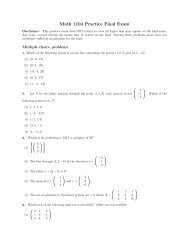Research Statement - Carleton University
Research Statement - Carleton University
Research Statement - Carleton University
Create successful ePaper yourself
Turn your PDF publications into a flip-book with our unique Google optimized e-Paper software.
4 Future <strong>Research</strong> Plan<br />
My goal is to be a research mathematician and an educator, and to make life-time commitment<br />
to mathematical research and training the next generation of mathematicians, scientists, and engineers.<br />
My ultimate plan is to make substantial contributions to the research of stochastic systems<br />
and game theory. In the next few years, my research plan is outline below.<br />
4.1 Further Topics in Stochastic Hybrid Systems<br />
The study of stochastic hybrid systems is still in an early stage. A number of problems remain<br />
open. Obtaining convergence rates for other numerical methods like Milstein scheme (see [28, 31])<br />
for regime-switching diffusion processes will have many significant applications, especially in the<br />
more challenging case that the switching component is diffusion-dependent. Next, concerning the<br />
degenerated switching diffusion, can we obtain a strong invariance principle? It appears that the<br />
desired result will be more difficult to obtain compared to the case of traditional diffusion process<br />
(see [16]) since one needs to deal with the Markov dependent component when estimating the<br />
moments. Also, it will be useful and natural to consider the regime-switching model for the system<br />
of many interacting particles in a random environment. Although some stability results in this<br />
direction when the number of particles is finite was obtained in [42, 44], there are still a lot of<br />
open questions on the asymptotic behavior of such systems when the number of particles becomes<br />
large. Attempts in finding answers to these questions present new challenges, which will lead to<br />
many substantial discoveries. Hence, my immediate future work will be devoted to the above<br />
problems. In addition, I will also focus on applications of the theoretical results of hybrid systems<br />
to real world problems including risk theory, financial engineering, stochastic approximation and<br />
stochastic optimization and control for stochastic hybrid systems.<br />
4.2 Mean-Field Game Theory and Stochastic McKean-Vlasov Equations<br />
In the past decade, the mean field games theory has been investigated intensively with many<br />
applications in wireless communication systems, biological science, and economics. However, this<br />
still is a relative new area with many open questions. In the future, I would like to focus on<br />
this topic. In particular, I am interested in the general problems in the mean field games theory<br />
with a large population of minor player and a major player which generalize the LQG cases (see<br />
[18, 19, 20]), numerical solutions for mean-field game and control problems (see [21]), and stochastic<br />
mean-field systems (see [9, 13]). In what follows, two specific problems will be described in more<br />
detail.<br />
Mean-Field Game Problem. In order to obtain low complexity strategies so that each player<br />
only needs to know its own state information, the consistent mean field approximation (see [18,<br />
19, 20]) is a powerful approach. For the general mean field game problems with a major player<br />
and a large population of minor players, this approach leads to the importance of investigating the<br />
limiting behavior of the empirical measure obtained by stochastic interacting particles described<br />
by the following equations<br />
(<br />
dx0(t) = f0 t, x0(t), ε N ) (<br />
x(t) dt + σ0 t, x0(t), ε N )<br />
x(t) dW0(t), (4.1)<br />
dxi(t) = f ( t, x0(t), xi(t), ε N )<br />
N∑<br />
x(t) dt + σ ( t, x0(t), xi(t), ε N x(t) , j) dWj(t), 1 ≤ i ≤ N (4.2)<br />
j=1<br />
where {Wi, 0 ≤ i ≤ N} are n dimensional independent standard Brownian motions, f0, σ0 : R ×<br />
R n × P → R n , f : R × R 2n × P → R n , σ : R × R 2n × P × {1, 2, ..., N} → R n , P is the set of<br />
8



